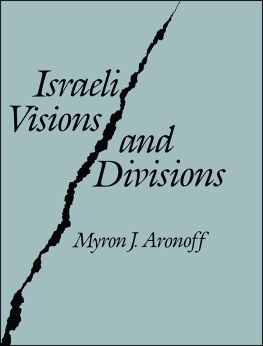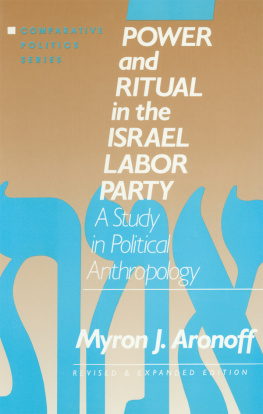First published 1989 by Transaction Publishers
Published 2017 by Routledge
2 Park Square, Milton Park, Abingdon, Oxon 0X14 4RN
711 Third Avenue, New York, NY 10017, USA
Routledge is an imprint of the Taylor & Francis Group, an informa business
Copyright 1989 by Taylor & Francis
All rights reserved. No part of this book may be reprinted or reproduced or utilised in any form or by any electronic, mechanical, or other means, now known or hereafter invented, including photocopying and recording, or in any information storage or retrieval system, without permission in writing from the publishers.
Notice:
Product or corporate names may be trademarks or registered trademarks, and are used only for identification and explanation without intent to infringe.
Library of Congress Catalog Number: 88-22002
Library of Congress Cataloging-in-Publication Data
Aronoff, Myron Joel.
Israeli visions and divisions : cultural change and political conflict / Myron J. Aronoff.
p. cm.
Bibliography: p.
Includes index.
ISBN 0-88738-255-X
1. Political partiesIsrael. 2. Political cultureIsrael. 3. IsraelPolitics and government. I. Title.
JQ1825.P37A76 1988
306.2095694dcl9 88-22002
CIP
ISBN 13: 978-0-88738-897-2 (pbk)
Acknowledgments
Thanking all of those who have made it possible for me to write this book is a formidable task. Were I able to do so adequately it would require a book-length section of acknowledgments to express my gratitude to the thousands of individuals and scores of institutions that have cooperated with my research on Israel over the past two decades. Many I have thanked in acknowledgments in previous publications and I reaffirm my gratitude to them here. However, were I even to list the hundreds of people whom I interviewed during my fieldwork in 198283, and in 198788 I fear that I would task the patience of my readers. Therefore I have listed by name only those whom I have directly quoted in my endnotes to the individual chapters.
Since I did not directly quote even half of those whom I interviewed, and since i learned a great deal from all who so generously gave of their time and expertise, I would like to extend first and foremost my profound gratitude to my informants. They include leading scholars from all of Israels universities, members of the government and the Knesset, religious leaders, representatives of Israels cultural establishment, and Israelis of every walk of life and ethnic group. Many are old friends and others are new ones. Indeed, one of the most gratifying aspects of anthropological fieldwork is the personal nature of the research. Every one of the people I interviewed and with whom I interacted provided a different insight and I wish to express my heartfelt gratitude to them all.
I gratefully acknowledge the generous support of the Joint Committee on the Near and Middle East of the American Council of Learned Societies and the Social Science Research Council who granted me funds provided by the National Endowment for the Humanities and the Ford Foundation. In addition Rutgers University awarded me a Faculty Academic Study Program leave and grant for the academic year 198283, and sent me back to Israel as director of its junior-year-abroad program again in 198788. I have also drawn upon previous research in Israel funded by the Social Science Research Council of the United Kingdom, by the Ford Foundation, and by the Bernstein Israel Research Trust.
I am particularly indebted to those individuals who have permitted me to quote from their unpublished work and to those who have taken the time to read various drafts of individual chapters of this manuscript and who gave me excellent criticism and suggestions for improving it. In many cases they have saved me from blunders or awkward phrases, for which they have my gratitude. They are to be completely exonerated from responsibility for any errors of fact or interpretation or clumsiness of style that may remain. I apologize if I inadvertently forgot anyone whose name should be included on this list. I wish collectively to thank for their helpful comments members of faculty seminars at Bar-Ilan University, Haifa University, the Hebrew University of Jerusalem, Tel Aviv University, and the University of Cape Town where I presented various parts of this work.
I am especially grateful to Rita Aronoff, Benjamin Beit-Hallahmi, Yoram Bilu, Dan Caspi, Jerold Green, Emanuel Gutmann, Don Handelman, Steven Heydemann, Irving Louis Horowitz, Aaron Klieman, Kay Lawson, Arnold Lewis, T. J. Pempel, Gerold Pomper,David Somer, Ehud Sprinzak, Alex Weingrod, and Yael Yishai.
Without the constant help, support, and encouragement of my life partner, best friend, and spouseRitaI could never have accomplished any of the things of which I am most proud. Since I have already dedicated my first book to her, she must be content with a very special expression of love and gratitude here.
This book is dedicated to the most important products of our collaboration, our beautiful and bright daughters Miriam and Yael. Besides being the most wonderful daughters parents could ever dream of having, they each made a contribution to this book. Miriam assisted in research on Peace Now, and Yael organized my newspaper files and read and commented on the manuscript. As an expression of gratitude, pride, and love I dedicate this book to them.
Contents
Introduction
After all, what is reality anyway? Nothin hut a collective hunch [Jane Wagner, The Search for Signs of Intelligent Life in the Universe].
Social imagination is constitutive of social reality [Paul Ricoeur, Lectures on Ideology and Utopia].
Conceptual Framework
This book examines the relationship between the changing political system and the political culture in Israel, with particular (but not exclusive) focus on the past decade. Since I use the concept political culture differently from most political scientists, I shall first define a few of the key terms I use throughout the book in order to clarify my conceptual approach.
My approach, which is anthropological, is based on the observation that human beings universally ascribe meaning to their actions and to those of others with whom they interact. The collective meanings that social groups create, share, and symbolically express, I call culture. Culture is based on assumptions that constitute a collective hunch, or shared perceptions of reality. Every culture at any given specific historical period will be characterized by a limited repertoire of particularly central and salient themes, which are symbolically expressed through myth and ritual and convey the values and goals most valued by or deemed most sacred to the collectivity at the time.
Two contradictory processes take place concurrently in all societies and cultures. On one hand, patterns of collective behavior become habitual and the collective meanings ascribed to them undergo a process of institutionalization or reification during which they tend to become taken for granted as they come to define reality for the members of the society.















